 |
||||||||||||||||||
|
|
||||||||||||||||||
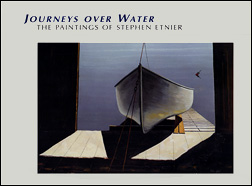 |
||||||||||||||||||
|
Journeys over Water
Essay for the 1998 exhibition catalog by Daniel. E. O'Leary, curator courtesy of Portland Museum of Art reproduced by permission. Presented in four parts: Introduction | I | II | III |
||||||||||||||||||
|
II. Adventure: 1942 to 1969
The second half of Stephen Etnier's life was an age of greater opportunities and fewer illusions, both for the artist and for America. Following World War II, his art reflects a shift from the sublime to the somber, discarding the casual charm of the previous era. (12) After his service in the U.S. Navy, the lightheartedness of the prewar period nevery fully returned to Stephen Etnier's paintings. The work of the early 1950s is characterized by desolate marine settings, sparsely lit early morning expanses, and austere winter scenes. A solemn mood emerges as his art becomes absorbed with atmosphere and isolation. The paintings often lack color and frequently are devoid of human figures. Light reflecting across still water becomes his fundamental preoccupation. From this period dates one of Etnier's most evocative paintings, Royal River, Yarmouth, Maine. Slight patches of blue provide the only suggestion of color in a silver and ebony expanse. The subdued light and the languid character of the painting create an aura of disenchantment. Obscure, threatening skies rise over a world that has become chilled and unnurturing, revealing a leaden landscape burnished by anemic patches of light. An impenetrable wall had risen between Etnier and the sublime and careless era of his early adulthood. The noticeable shift towards a more somber palette and a bleaker vision may have been the direct result of his wartime experiences, the conflicts leading to his divorce from Elizabeth in 1948, and the death in 1949 of his third wife, Jane Pearce. (13) The works of the early 1950s, which are among his most visionary and serious efforts, radiate ennui and stasis. If the prewar paintings imply confidence and equanimity, the postwar works suggest uncertainty an troubled reflection. During the decade following the war, Etnier increased his travels and pursued his interest in painting in exotic locations. When figures are included in the works of the 1950s, they generally convey a sense of hardship and anxiety. A striking example is found in Prison Quarry, Jamaica. Employing an exaggerated perspective, Etnier places small and abstracted figures within the overwhelming expanse of a salt mine. The provocative irony of the painting lies in its focus on penal servitude within a tropical paradise. Etnier addresses the disconcerting issue of captivity, suggesting perhaps that even the life of an artist comprises a captive state and that every life is circumscribed and constrained. The paintings of the later 1950s and early 1960s combine rigidity of form, stark linearity, and capricious, artificial colors to form a style that could be described as late Deco or 1950s modern. It was during this phase that Etnier settled upon a standard frame for his works that employed coarse brown "driftwood" slates and broad linen liners. Etnier's second style had much in common with the "modern" furniture and austere decorating tendencies of the 1950s. His fascination with consumer culture imagery and his keen awareness of advertising, signage, and brand names also become increasingly evident in this period. Etnier's work of the 1950s anticipates the interest in popular culture that dominated in the art of the following decade and can be seen at times as proto-pop. In his work of the 1950s and 1960s as in the prewar period Etnier again employed the camera as a starting point, but in a new and distinctive fashion. The snapshot - in opposition to the more formal photograph - became his favorite tool. Many of his paintings resemble snapshots: they are characterized by tightly and arbitrarily cropped subjects, dramatic and exaggerated views, and a seemingly random placement of figures. In Cool of the Day, Barbados, Etnier used a small Polariod photograph as his source and enhanced several of its most provocative features. He included the slanted brand name "Kelly's," the bottle, the word "Rum," the dark doorway, the corrugated roof, and the railroad tracks in the foreground. The tree and figures were rearranged, a seascape and railroad signals were added, and refined elements of color and light were provided. Still, the painting retains much of the photograph's basic form and character. Etnier's small Polariod is a cogent work of art, demonstrating his understanding of the camera's potential as an aesthetic tool. The Polariod camera that Etnier used created a noticeably exaggerated perspective. The distance from the foreground to the horizon in these small photos was enhanced by the lens, a quality that Etnier tended to emphasize by setting figures and details in the extreme foreground. Polariod photos became useful notations that often evolved into paintings, particularly during his Caribbean travels and on board vessels. Etnier used the camera to record memorable locations, to explore creative cropping, and to pose or capture figures in striking configurations. In Tidal Pool, Etnier simplified the background of a Polaroid snapshot, retaining the images of his two sons, David and John, as they explored potential locations for launching a toy boat. Etnier altered the small craft and enlarged the pattern of concentric circles that it created. It is likely the the interaction of water and light was a crucial motivation for taking the photo and for proceeding with the painting. Figurative subjects are rare in Etnier's career. His concentration on landscapes during the 1950s and 1960s demonstrates a strong preference for unspoiled and solitary locations. Having made his choice to live on the harsh and inspiring coast of Harpswell, Maine, Etnier enforced a discipline that enabled him to record extensive areas of the region. He worked in Maine through most of the year and traveled south each winter, usually navigating his own vessels and retaining the role of careful observer of the landscape, the environment, and the era. A precise sense of place, which is frequently absent from twentieth-century art, is always fundamental to his work. For the remainder of his life Etnier showed a growing inclination to explore and record the coast of Maine. It is from the mid-1960s on that the majority of his Maine coast subjects emerge. These works, which could easily constitute an exhibition in themselves, document many of the key landmarks of Maine and provide carefully observed records of harbors and sites. Etnier used photographs in a flexible and unobtrusive manner, and was adept at capturing figures in candid and striking poses. Probably because of his photographic approach, he spoke of himself as a "part realist." The work of the 1960s represents a period of enhanced refinement and subtlety in his work. Etnier's painstaking reverence for detail and his obsession with optical effects and illumination at times approached the extreme clarity of photo-realism. As Etnier worked through the sixties, his color schemes became less muted and grew vivid, artificial, and eccentric. The colors - often vigorous oranges, saturated pinks, and neon greens - reflect retail and fashion trends of the period. His dynamic colors often recall the flamboyant automotive hues then current. The 1960s represent the most highly stylized phase in Etnier's career. His treatment of objects and figures often turned angular and geometric. Geometry grew to become an essential element in his work, enhanced by rigid forms and an exaggerated use of perspective. Mazatlan Waterfront, although ostensibly a picturesque landscape, is actually a highly artificial pattern of verticals and diagonals. The abstract nature of the painting is augmented by the elegance of the color scheme, the curious placement of objects, and the sublime and surreal presence of the monumental cliffs on the horizon. Etnier clearly found remote sites to be fertile locations for his adventures as a painter during the 1960s. Among the most dramatic examples of his enthusiasm for intriguing and incongruous settings, and for modern technology, are his paintings of the curious structures represented in Telecommunications Forward Scatter Site, Nassau. The cryptic nature of this scene, which Etnier painted twice, and in unusual scale, epitomizes his tendency to respond to enigmatic phenomena. The serene and gentle backdrop of the sky, as it descends from pale blue through rose-tinted clouds to a murky haze at the horizon, is powerfully etched by the dark, precise silhouettes of the structures that dominate the setting. The white fence or barrier in the foreground regiments the painting as though it were a page taken from a musical score. The painting is a refined pattern of graceful curves and meticulous lines, as elegant and inexplicable as an isolated character of Chinese calligraphy. The majority of the paintings of this period, however, are small, probably as a consequence of Etnier's travels. Dozens of pictures commemorate journeys by water and feature isolated sites. In addition to his usual openness to the aesthetics of machinery and random objects, Etnier shows a growing fascination with flamboyant coastal architecture, including stores, taverns, and honky-tonk settings. Etnier's work of the later 1950s and 1960s represents the period when his most characteristic and recognizable style emerged. The stability of his life during his thirty-three-year marriage to Samuella Rose, her willingness to manage the business and domestic aspects of their life together, and their comfortable existence in Harpswell with their two sons provided an equilibrium that allowed Etnier to focus on his painting. By the mid-1960s Etnier had developed a balanced approach to his work that allowed that decade to become the most prolific phase of his career. (14) The paintings of Stephen Etnier during the 1950s and 1960s are enriched by the vitality and discordance of post-World War II America. They are records both of the artist's own personal growth and of his society's evolution.
|
||||||||||||||||||
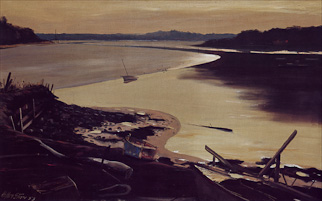 |
||||||||||||||||||
| Royal River, Yarmouth, Maine 1953 Collection of William Farley |
||||||||||||||||||
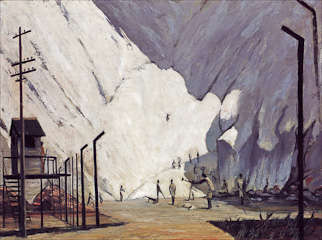 |
||||||||||||||||||
| Prison Quarry, Jamaica 1951 Bates College Museum of Art |
||||||||||||||||||
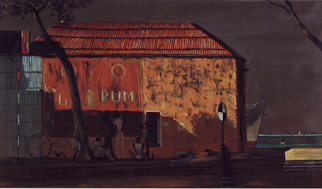 |
||||||||||||||||||
| Cool of the Day, Barbados 1954 Private collection |
||||||||||||||||||
 |
||||||||||||||||||
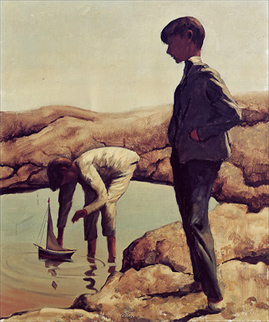 |
||||||||||||||||||
| Tidal Pool 1964 Portland Museum of Art |
||||||||||||||||||
 |
||||||||||||||||||
 |
||||||||||||||||||
| Mazatlan Waterfront, 1961 collection of David M. Etnier |
||||||||||||||||||
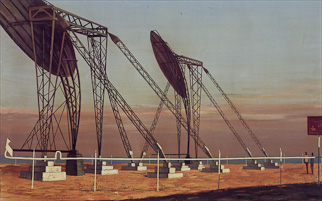 |
||||||||||||||||||
| Telecommunications Forward Scatter Site, Nassau (#2) 1960 collection of Mrs. A. Earl Cullum, Jr. |
||||||||||||||||||